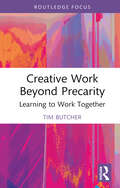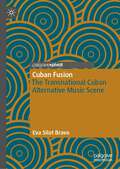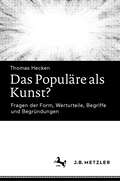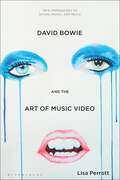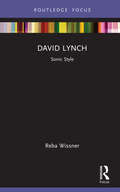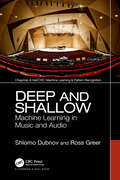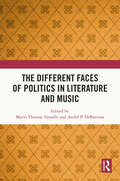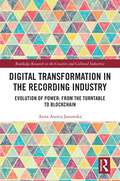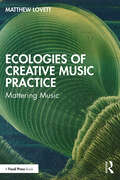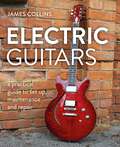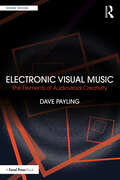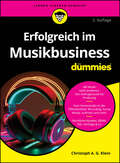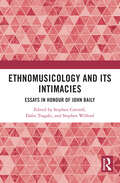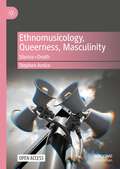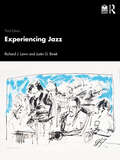- Table View
- List View
Creative Work Beyond Precarity: Learning to Work Together (Routledge Focus on the Global Creative Economy)
by Tim ButcherThis book offers an original critical evaluation of how freelance careers can be established and sustained in the increasingly uncertain global creative economy. Developing from the author’s theoretical and empirical research at the nexus of precarious work and entrepreneurial learning, it provides an in-depth understanding of why and how creatives can learn to become entrepreneurial and how this relates to creative entrepreneurship. This book traces how arts work became creative labour and explores the contemporary organisation of artistic and creative practices to understand practical alternatives to the individualised careers we currently feel responsible for maintaining. Inspired particularly by the work of Raymond Williams, creative work is reconceptualised as practice-based collaborative learning encounters through which we might put shared feelings of precarity to work towards the production and practice of alternative possibilities. Accessible and concise, breaking down complex concepts through practical examples and linking the creative process to entrepreneurial learning, this book will be of interest to students, educators and researchers studying and working in the creative economy.
Creative Work Beyond Precarity: Learning to Work Together (Routledge Focus on the Global Creative Economy)
by Tim ButcherThis book offers an original critical evaluation of how freelance careers can be established and sustained in the increasingly uncertain global creative economy. Developing from the author’s theoretical and empirical research at the nexus of precarious work and entrepreneurial learning, it provides an in-depth understanding of why and how creatives can learn to become entrepreneurial and how this relates to creative entrepreneurship. This book traces how arts work became creative labour and explores the contemporary organisation of artistic and creative practices to understand practical alternatives to the individualised careers we currently feel responsible for maintaining. Inspired particularly by the work of Raymond Williams, creative work is reconceptualised as practice-based collaborative learning encounters through which we might put shared feelings of precarity to work towards the production and practice of alternative possibilities. Accessible and concise, breaking down complex concepts through practical examples and linking the creative process to entrepreneurial learning, this book will be of interest to students, educators and researchers studying and working in the creative economy.
Cuban Fusion: The Transnational Cuban Alternative Music Scene
by Eva Silot BravoSurveying the impact of Cuba's economic crisis after the demise of the eastern socialist block, this book documents a relatively unexplored transnational network of collaborations among Cuban musicians that migrated to many different countries from the 1990s forward. The book’s main argument is that in light of the 1990s crisis in Cuba, new transnational and alternative narratives emerged, resulting in creative “in-between” spaces that reflect a post- socialist aesthetic condition. The manuscript also documents important developments in the Cuban jazz and fusion scenes outside the island in the last 20+ years..
Das auditive Netz: Künstlerische Forschung im medialen Dazwischen (Musik und Klangkultur #69)
by Hans-Ulrich WernerWas macht künstlerisches Forschen im Bereich Sound und Musik aus? Im Ausklang einer langen und produktiven technisch-künstlerischen sowie wissenschaftlichen Laufbahn stellt Hans-Ulrich Werner seine Ergebnisse zum Thema vor. Dazu orientiert er sich vor allem an den Ideen und Erkenntnissen der Menschen, denen er bei seinem Schaffen begegnete und die er als Akteure eines internationalen Netzes beschreibt. Somit ergibt sich nicht nur ein Einblick in die Protagonisten der vielfältigen Klanglandschaften dieser Welt, sondern auch die Etablierung des künstlerischen Forschens als eigenständige Disziplin jenseits von klassischer Wissenschaft.
Das Populäre als Kunst?: Fragen der Form, Werturteile, Begriffe und Begründungen
by Thomas HeckenPopulären Werken wird seit Jahrhunderten der Status des Kunstwerks aberkannt, unter Verweis auf deren vermeintliche Oberflächlichkeit, Eindimensionalität, Effekthascherei und Standardisierung werden sie streng von ‚echter‘ Kunst geschieden. Schiller, Nietzsche, Adorno, Greenberg, unzählige Kritiker und Feuilletonisten in Westeuropa und den USA – sie alle eint ein starker Vorbehalt gegenüber dem, was von den Vielen anerkannt, geschätzt und gekauft wird. Seit Beginn des 18. Jahrhunderts und besonders seit den 1950er Jahren gibt es aber auch eine Reihe von Argumenten gegen die Auffassung, dass nichts Kunst sei, was auf große Zustimmung trifft. Die Fülle an unterschiedlichen Positionen, Aussagen und Argumentationsmöglichkeiten aufzuzeigen, zu bündeln, zu systematisieren und zu überprüfen, die dem Populären zu künstlerischer Anerkennung verhelfen wollen, ist Zweck dieses Buches. Das Resultat ist eine umfassende Darstellung von Gründen, auch populäre Werke aus Literatur, Musik, Film,Fotografie, bildender Kunst und Design als genuine Kunstwerke betrachten zu können.
David Bowie and the Art of Music Video (New Approaches to Sound, Music, and Media)
by Dr. Lisa PerrottThe first in-depth study of David Bowie's music videos across a sustained period takes on interweaving storyworlds of an iconic career. Remarkable for their capacity to conjure elaborate imagery, Bowie's videos provide fascinating exemplars of the artistry and remediation of music video. When their construction is examined across several years, they appear as time-travelling vessels, transporting kooky characters and strange story-world components across time and space. By charting Bowie's creative and collaborative process across five distinct phases, David Bowie and the Art of Music Video shows how he played a vital role in establishing music video as an artform. Filling a gap in the existing literature, this book shines a light on the significant contributions of directors such as Mick Rock, Stanley Dorfman and David Mallet, each of whom taught Bowie much about how to use the form. By examining Bowie's collaborative process, his use of surrealist strategies and his integration of avant-garde art with popular music and media, the book provides a history of music video in relation to the broader fields of audiovisual media, visual music and art.
David Lynch: Sonic Style (Filmmakers and Their Soundtracks)
by Reba WissnerDirector David Lynch is best known for films that channel the uncanny and the weird into a distinct "Lynchian" aesthetic, in which sound and music play a key role: Lynch not only writes his intended sounds into the script but also often takes on the role of creating the sounds himself. This concise study explores what makes Lynch’s sonic imprint distinct, breaking down three different sound styles that create Lynch’s sound aesthetic across his films. Showing how sound offers new insights into the aesthetic and narrative work of Lynch’s filmmaking, this book highlights new dimensions in the work of a key American auteur and deconstructs the process of building a unique sound world.
David Lynch: Sonic Style (Filmmakers and Their Soundtracks)
by Reba WissnerDirector David Lynch is best known for films that channel the uncanny and the weird into a distinct "Lynchian" aesthetic, in which sound and music play a key role: Lynch not only writes his intended sounds into the script but also often takes on the role of creating the sounds himself. This concise study explores what makes Lynch’s sonic imprint distinct, breaking down three different sound styles that create Lynch’s sound aesthetic across his films. Showing how sound offers new insights into the aesthetic and narrative work of Lynch’s filmmaking, this book highlights new dimensions in the work of a key American auteur and deconstructs the process of building a unique sound world.
Deep and Shallow: Machine Learning in Music and Audio
by Shlomo Dubnov Ross GreerProviding an essential and unique bridge between the theories of signal processing, machine learning, and artificial intelligence (AI) in music, this book provides a holistic overview of foundational ideas in music, from the physical and mathematical properties of sound to symbolic representations. Combining signals and language models in one place, this book explores how sound may be represented and manipulated by computer systems, and how our devices may come to recognize particular sonic patterns as musically meaningful or creative through the lens of information theory. Introducing popular fundamental ideas in AI at a comfortable pace, more complex discussions around implementations and implications in musical creativity are gradually incorporated as the book progresses. Each chapter is accompanied by guided programming activities designed to familiarize readers with practical implications of discussed theory, without the frustrations of free-form coding. Surveying state-of-the art methods in applications of deep neural networks to audio and sound computing, as well as offering a research perspective that suggests future challenges in music and AI research, this book appeals to both students of AI and music, as well as industry professionals in the fields of machine learning, music, and AI.
Deep and Shallow: Machine Learning in Music and Audio
by Shlomo Dubnov Ross GreerProviding an essential and unique bridge between the theories of signal processing, machine learning, and artificial intelligence (AI) in music, this book provides a holistic overview of foundational ideas in music, from the physical and mathematical properties of sound to symbolic representations. Combining signals and language models in one place, this book explores how sound may be represented and manipulated by computer systems, and how our devices may come to recognize particular sonic patterns as musically meaningful or creative through the lens of information theory. Introducing popular fundamental ideas in AI at a comfortable pace, more complex discussions around implementations and implications in musical creativity are gradually incorporated as the book progresses. Each chapter is accompanied by guided programming activities designed to familiarize readers with practical implications of discussed theory, without the frustrations of free-form coding. Surveying state-of-the art methods in applications of deep neural networks to audio and sound computing, as well as offering a research perspective that suggests future challenges in music and AI research, this book appeals to both students of AI and music, as well as industry professionals in the fields of machine learning, music, and AI.
The Different Faces of Politics in Literature and Music
by Mario Thomas Vassallo André P. DeBattistaThis book highlights the links between politics and governance and the arts. The essays in the volume show how literature and music have challenged those in power risking political censure. In addition, they also try to delineate how patronage has been used for propaganda, or to stir up national fervour. They focus on the tension and symbiosis between the politician and the artist foregrounding how they have always tried to influence, challenge, and, in some cases, undermine one another. This volume will serve as an indispensable source for researchers and academics in political science, the humanities and performing arts.
The Different Faces of Politics in Literature and Music
by Mario Thomas Vassallo Andre P. DeBattistaThis book highlights the links between politics and governance and the arts. The essays in the volume show how literature and music have challenged those in power risking political censure. In addition, they also try to delineate how patronage has been used for propaganda, or to stir up national fervour. They focus on the tension and symbiosis between the politician and the artist foregrounding how they have always tried to influence, challenge, and, in some cases, undermine one another. This volume will serve as an indispensable source for researchers and academics in political science, the humanities and performing arts.
Digital Transformation in The Recording Industry: Evolution of Power: From The Turntable To Blockchain (Routledge Research in the Creative and Cultural Industries)
by Anna Anetta JanowskaThe recording industry has famously been transformed by technology throughout its entire history.The book presents an analysis of these changes using Porter's five forces model. The author highlights the evolution of buyers' and suppliers' power, the emergence of new competitors, product innovation and rivalry between companies in the industry driven by economic, political, social and legal factors.As an early mover in the social diffusion of copyright-sensitive content, the recording industry reflected in this book serves as an important reference for the analysis of other cultural and creative sectors.
Digital Transformation in The Recording Industry: Evolution of Power: From The Turntable To Blockchain (Routledge Research in the Creative and Cultural Industries)
by Anna Anetta JanowskaThe recording industry has famously been transformed by technology throughout its entire history.The book presents an analysis of these changes using Porter's five forces model. The author highlights the evolution of buyers' and suppliers' power, the emergence of new competitors, product innovation and rivalry between companies in the industry driven by economic, political, social and legal factors.As an early mover in the social diffusion of copyright-sensitive content, the recording industry reflected in this book serves as an important reference for the analysis of other cultural and creative sectors.
Ecologies of Creative Music Practice: Mattering Music
by Matthew LovettEcologies of Creative Music Practice: Mattering Music explores music as a dynamic practice embedded in contemporary ecological contexts, one that both responds to, and creates change within, the ecologies in which it is created and consumed. This highly interdisciplinary analysis includes theoretical and practical considerations – from blockchain technology and digital platform commerce to artificial intelligence and the future of work, to sustainability and political ecology – as well as contemporary philosophical paradigms, guiding its investigation through three main lenses: How can music work as a conceptual tool to interrogate and respond to our changing global environment? How have transformations in our digital environment affected how we produce, distribute and consume music? How does music relate to matters of political ecology and environmental change? Within this framework, music is positioned as a starting point from which to examine a range of contexts and environments, offering new perspectives on contemporary technological and ecological discourse. Ecologies of Creative Music Practice: Mattering Music is a valuable text for advanced undergraduates, postgraduates, researchers and practitioners concerned with producing, performing, sharing and listening to music.
Ecologies of Creative Music Practice: Mattering Music
by Matthew LovettEcologies of Creative Music Practice: Mattering Music explores music as a dynamic practice embedded in contemporary ecological contexts, one that both responds to, and creates change within, the ecologies in which it is created and consumed. This highly interdisciplinary analysis includes theoretical and practical considerations – from blockchain technology and digital platform commerce to artificial intelligence and the future of work, to sustainability and political ecology – as well as contemporary philosophical paradigms, guiding its investigation through three main lenses: How can music work as a conceptual tool to interrogate and respond to our changing global environment? How have transformations in our digital environment affected how we produce, distribute and consume music? How does music relate to matters of political ecology and environmental change? Within this framework, music is positioned as a starting point from which to examine a range of contexts and environments, offering new perspectives on contemporary technological and ecological discourse. Ecologies of Creative Music Practice: Mattering Music is a valuable text for advanced undergraduates, postgraduates, researchers and practitioners concerned with producing, performing, sharing and listening to music.
Electric Guitars: A Practical Guide to Set Up, Maintenance and Repair
by James CollinsThis practical guide considers everything you need to know, from the instrument's initial set up through to maintenance and repairs. An invaluable resource for beginners who want to learn to set up and look after their guitars, to aspiring and professional touring techs who want to work on other people's guitars.
Electronic Visual Music: The Elements of Audiovisual Creativity (Sound Design)
by Dave PaylingElectronic Visual Music is a comprehensive guide to the composition and performance of visual music, and an essential text for those wanting to explore the history, current practice, performance strategies, compositional methodologies and practical techniques for conceiving and creating electronic visual music. Beginning with historical perspectives to inspire the reader to work creatively and develop their own individual style, visual music theory is then discussed in an accessible form, providing a series of strategies for implementing ideas. Including interviews with current practitioners, Electronic Visual Music provides insight into contemporary working methods and gives a snapshot of the state of the art in this ever-evolving creative discipline. This book is a valuable resource for artists and practitioners, as well as students, educators and researchers working in disciplines such as music composition, music production, video arts, animation and related media arts, who are interested in informing their own work and learning new strategies and techniques for exploration and creative expression of electronic visual music.
Electronic Visual Music: The Elements of Audiovisual Creativity (Sound Design)
by Dave PaylingElectronic Visual Music is a comprehensive guide to the composition and performance of visual music, and an essential text for those wanting to explore the history, current practice, performance strategies, compositional methodologies and practical techniques for conceiving and creating electronic visual music. Beginning with historical perspectives to inspire the reader to work creatively and develop their own individual style, visual music theory is then discussed in an accessible form, providing a series of strategies for implementing ideas. Including interviews with current practitioners, Electronic Visual Music provides insight into contemporary working methods and gives a snapshot of the state of the art in this ever-evolving creative discipline. This book is a valuable resource for artists and practitioners, as well as students, educators and researchers working in disciplines such as music composition, music production, video arts, animation and related media arts, who are interested in informing their own work and learning new strategies and techniques for exploration and creative expression of electronic visual music.
Erfolgreich im Musikbusiness für Dummies (Für Dummies)
by Christoph A. KleinSo wird das Showbusiness Ihr Business Tauchen Sie ein in die Welt der Musik und entdecken Sie, wie Sie als leidenschaftlicher Musiker oder Produzent den Sprung auf die große Bühne schaffen! Christoph Klein führt Sie durch den Dschungel von GEMA, GVL und Künstlersozialkasse, wirft einen Blick auf die juristischen Feinheiten und entwirrt den Knoten von Plattenverträgen und Co. In diesem Buch erfahren Sie alles über die wichtigsten Player der Musikindustrie, wie Sie effektives Marketing betreiben und was bei professionellen Aufnahmen und Liveauftritten zu beachten ist. Zahlreiche Checklisten, Musterverträge und hilfreiche Adressen machen es zum unverzichtbaren Begleiter auf Ihren Weg zum Erfolg. Sie erfahren Wie Sie sich auf dem Musikmarkt erfolgreich positionieren Wer im Musikbusiness alles mitwirkt Was Sie bei GEMA und Co beachten sollten Wie Sie Social Media optimal für Ihre Musik einsetzen
Ethnomusicology and its Intimacies: Essays in Honour of John Baily
by Stephen Cottrell, Dafni Tragaki, and Stephen WilfordEthnomusicology and its Intimacies situates intimacy, a concept that encompasses a wide range of often informal social practices and processes for building closeness and relationality, within the ethnomusicological study of music and sound. These scholarly essays reflect on a range of interactions between individuals and communities that deepen connections and associations, and which may be played out relatively briefly or nurtured over time. Three major sections on Performance, Auto/biographical Strategies, and Film are each prefaced by an interview with a scholar or practitioner with close knowledge of the subject that links the chapters in that section. Often drawing directly on fieldwork experience in a variety of contexts, authors consider how concepts of intimacy can illuminate the ethnographic study of music, addressing questions such as: how can we understand ethnomusicological and ethnographic research and performance as processes of musically mediated intimacy? How are the longstanding relationships we develop with others particularly intimated by and through musicking? How do we understand the musically intimate relationships of others and how do these inflect our own musical intimacies? How does music represent, inscribe, constrain, or provoke social or personal intimacies in particular contexts? The volume will appeal to all scholars with interests in music and how it is used to construct relationships in different contexts around the world.
Ethnomusicology and its Intimacies: Essays in Honour of John Baily
Ethnomusicology and its Intimacies situates intimacy, a concept that encompasses a wide range of often informal social practices and processes for building closeness and relationality, within the ethnomusicological study of music and sound. These scholarly essays reflect on a range of interactions between individuals and communities that deepen connections and associations, and which may be played out relatively briefly or nurtured over time. Three major sections on Performance, Auto/biographical Strategies, and Film are each prefaced by an interview with a scholar or practitioner with close knowledge of the subject that links the chapters in that section. Often drawing directly on fieldwork experience in a variety of contexts, authors consider how concepts of intimacy can illuminate the ethnographic study of music, addressing questions such as: how can we understand ethnomusicological and ethnographic research and performance as processes of musically mediated intimacy? How are the longstanding relationships we develop with others particularly intimated by and through musicking? How do we understand the musically intimate relationships of others and how do these inflect our own musical intimacies? How does music represent, inscribe, constrain, or provoke social or personal intimacies in particular contexts? The volume will appeal to all scholars with interests in music and how it is used to construct relationships in different contexts around the world.
Ethnomusicology, Queerness, Masculinity: Silence=Death
by Stephen AmicoThis open access book explores the disciplinary, disciplined, and recent interdisciplinary sites and productions of ethnomusicology and queerness, arguing that both academic realms are founded upon a destructive masculinity—indissolubly linked to coloniality and epistemic hegemony—and marked by a monologic, ethnocentric silencing of embodied, same-sex desire. Ethnomusicology’s fetishization of masculinizing fieldwork; queerness’s functioning as Anglophone master category; and both domains’ devaluation of sensuality and experience, concomitant with an adherence to provincial, Western conceptions of knowledge production, are revealed as precluding the possibilities for equitable, dialogic pluriversality. Enlisting the sonic as theoretical intervention, the disciplined/disciplining ethno and queer are reimagined in relation to negative emotions and intractable affect, ultimately vanquished, and replaced by explorations of sound, sex/uality, and experiential somaticity within a protean, postdisciplinary space of material/epistemic equity. This uncompromising, long-overdue critique will be of interest to researchers and students from numerous theoretical backgrounds, including music, sound, gender, queer, and postcolonial/decolonial studies.
Experiencing Jazz
by Richard J. Lawn Justin G. BinekExperiencing Jazz, Third Edition is an integrated textbook, website, and audio anthology for jazz appreciation and history courses. Through readings, illustrations, timelines, listening guides, and a playlist of tracks and performances, Experiencing Jazz journeys through the history of jazz and places the music within larger cultural and historical contexts. Designed for the jazz novice, this textbook introduces the reader to prominent artists, covers the evolution of styles, and makes stylistic comparisons to current trends and developments. New to the third edition: Richard J. Lawn is joined by new co-author Justin G. Binek Expanded coverage of artists, particularly important vocalists and prominent women in jazz, including Bobby McFerrin, Kurt Elling, The Manhattan Transfer, and Terri Lyne Carrington A dynamic, web-exclusive bonus chapter—Chapter 14.5: The Story Continues—exploring contemporary jazz artists who push the boundaries of jazz by creating new stylistic fusions and who utilize new media to create, collaborate, and share their artistry A re-worked companion website featuring new recordings, a more comprehensive audio anthology, and a major revision of The Elements of Jazz section Condensed musician biographies and updated content reflecting jazz’s global impact Revised listening guides for spotlighted recordings highlighting key moments worthy of closer listening and analysis Comprehensive and immersive, the third edition of Experiencing Jazz provides a foundational understanding of the history of the genre.
Experiencing Jazz
by Richard J. Lawn Justin G. BinekExperiencing Jazz, Third Edition is an integrated textbook, website, and audio anthology for jazz appreciation and history courses. Through readings, illustrations, timelines, listening guides, and a playlist of tracks and performances, Experiencing Jazz journeys through the history of jazz and places the music within larger cultural and historical contexts. Designed for the jazz novice, this textbook introduces the reader to prominent artists, covers the evolution of styles, and makes stylistic comparisons to current trends and developments. New to the third edition: Richard J. Lawn is joined by new co-author Justin G. Binek Expanded coverage of artists, particularly important vocalists and prominent women in jazz, including Bobby McFerrin, Kurt Elling, The Manhattan Transfer, and Terri Lyne Carrington A dynamic, web-exclusive bonus chapter—Chapter 14.5: The Story Continues—exploring contemporary jazz artists who push the boundaries of jazz by creating new stylistic fusions and who utilize new media to create, collaborate, and share their artistry A re-worked companion website featuring new recordings, a more comprehensive audio anthology, and a major revision of The Elements of Jazz section Condensed musician biographies and updated content reflecting jazz’s global impact Revised listening guides for spotlighted recordings highlighting key moments worthy of closer listening and analysis Comprehensive and immersive, the third edition of Experiencing Jazz provides a foundational understanding of the history of the genre.
